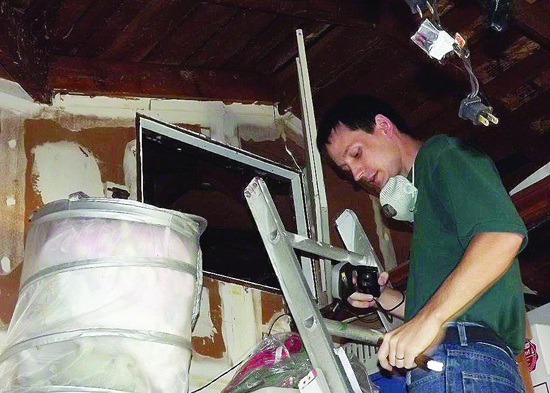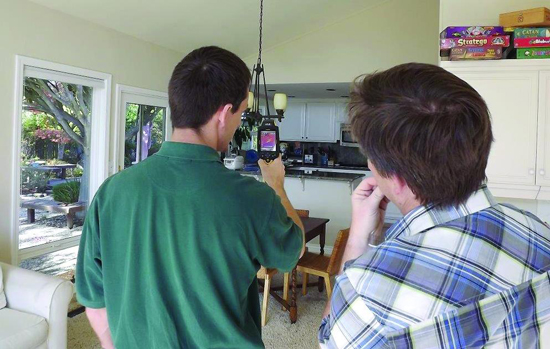| | Published January 15th, 2014
| Home Energy Audit Identifies Energy Inefficiencies
| | By Cathy Dausman |  | | Kyle Bosworth of Eco Performance Builders inspects the Penneys' home. Photo Cathy Dausman
|
As Charles Warner famously quipped, "Everybody complains about the weather, but nobody does anything about it." Mr. Warner, meet the Penneys.
 Damian and Laurel Penney bought a 40-year-old ranch home in Moraga three years ago and have lived with its energy imperfections ever since. "We run the heater, and the house instantly cools down," Damian Penney complained. "We want more bang for our buck."
Damian and Laurel Penney bought a 40-year-old ranch home in Moraga three years ago and have lived with its energy imperfections ever since. "We run the heater, and the house instantly cools down," Damian Penney complained. "We want more bang for our buck."
 Tired of stashing blankets to snuggle under near living room chairs or raising the thermostat to stay comfortable (Damian Penney) only to see it lowered to minimize energy costs (Laurel Penney), the couple hired Eco Performance Builders to assess their comfort zone and establish project priorities.
Tired of stashing blankets to snuggle under near living room chairs or raising the thermostat to stay comfortable (Damian Penney) only to see it lowered to minimize energy costs (Laurel Penney), the couple hired Eco Performance Builders to assess their comfort zone and establish project priorities.
 The company sent Kyle Bosworth, who has two years on the job and is Building Performance Institute certified as an analyst. Bosworth set to work using a laptop, a blower door, infra-red camera and a digital measuring tape; he inspected attic and crawl spaces, hooked up a blower to run air flow tests, and measured the air cubic volume in each room. And since Bosworth teaches building analysis, he narrated his findings.
The company sent Kyle Bosworth, who has two years on the job and is Building Performance Institute certified as an analyst. Bosworth set to work using a laptop, a blower door, infra-red camera and a digital measuring tape; he inspected attic and crawl spaces, hooked up a blower to run air flow tests, and measured the air cubic volume in each room. And since Bosworth teaches building analysis, he narrated his findings.
 A home is a product of a dozen interconnected systems, he said; duct leakage and combustion safety are two common energy/performance failures. Unwanted heating or cooling losses always occur through the path of least resistance - for example, through single-pane windows, under-wrapped HVAC ductwork and under-insulated walls and attics. Skylights and attic knee walls sometimes lack insulation, which works best when it is sealed tightly to the surface.
A home is a product of a dozen interconnected systems, he said; duct leakage and combustion safety are two common energy/performance failures. Unwanted heating or cooling losses always occur through the path of least resistance - for example, through single-pane windows, under-wrapped HVAC ductwork and under-insulated walls and attics. Skylights and attic knee walls sometimes lack insulation, which works best when it is sealed tightly to the surface.
 New construction insulation standards, expressed in "R" values, include R-6 for ducts, R-13 for walls and R-38 for ceilings. Windows are especially poorly insulated, and the Penneys knew their street-facing windows were only single pane. On the mild autumn test day the sun shone steadily through eastern and south-facing living room windows. The infra-red camera showed east facing walls heated to 88 degrees and south facing walls at 86 degrees.
New construction insulation standards, expressed in "R" values, include R-6 for ducts, R-13 for walls and R-38 for ceilings. Windows are especially poorly insulated, and the Penneys knew their street-facing windows were only single pane. On the mild autumn test day the sun shone steadily through eastern and south-facing living room windows. The infra-red camera showed east facing walls heated to 88 degrees and south facing walls at 86 degrees.
 "If it's a really hot day we'll run the air conditioning before we do infra-red testing," Bosworth said.
"If it's a really hot day we'll run the air conditioning before we do infra-red testing," Bosworth said.
 HVAC returns are another item homeowners want properly sealed. The Penneys' supply and return ducts efficiency averaged a lowly R1. "There are places where bare sheet metal shows through the ductwork," Boswell said. Even heat registers should be properly sealed, using aluminum foil tape, not duct tape, because leaky returns present air quality issues in the house as well as energy loss.
HVAC returns are another item homeowners want properly sealed. The Penneys' supply and return ducts efficiency averaged a lowly R1. "There are places where bare sheet metal shows through the ductwork," Boswell said. Even heat registers should be properly sealed, using aluminum foil tape, not duct tape, because leaky returns present air quality issues in the house as well as energy loss.
 Bosworth blower-tested the air ducts, measured airflow and air temperatures at all the registers. He checked the furnace and hot water heater temperatures. Accessing the attic, Bosworth noted it contained 5-inch deep blown-in fiberglass insulation, far less than the 12 to 13 inches recommended, and the floor of the attic was not air sealed prior to insulating. A home needs a sealed air barrier next to its insulation barrier to be fully effective.
Bosworth blower-tested the air ducts, measured airflow and air temperatures at all the registers. He checked the furnace and hot water heater temperatures. Accessing the attic, Bosworth noted it contained 5-inch deep blown-in fiberglass insulation, far less than the 12 to 13 inches recommended, and the floor of the attic was not air sealed prior to insulating. A home needs a sealed air barrier next to its insulation barrier to be fully effective.
 "If you go outside on a cold windy day in a wool sweater you will still be cold" unless you have a windbreaker, too, he said. The crawl space evaluation proved even more challenging; its sheet metal was crushed in many locations. Bosworth had his raw data in six hours; a week later the Penneys received their comprehensive (45 page) evaluation, complete with suggested upgrades.
"If you go outside on a cold windy day in a wool sweater you will still be cold" unless you have a windbreaker, too, he said. The crawl space evaluation proved even more challenging; its sheet metal was crushed in many locations. Bosworth had his raw data in six hours; a week later the Penneys received their comprehensive (45 page) evaluation, complete with suggested upgrades.
 Energy modifications were presented in a good, better, best format. The Penneys' wall batt insulation had an R-10.5 rating, which Bosworth called "mostly effective" but with some weak spots. HVAC ductwork lost 43 percent efficiency (statewide the average loss is 30 percent) due to poor R-1 insulation, and the boots (metal transition between ducts and heat vents) were asbestos wrapped. The heater and air conditioning unit was oversized at 4 tons (a 2 ton AC unit, would have been better).
Energy modifications were presented in a good, better, best format. The Penneys' wall batt insulation had an R-10.5 rating, which Bosworth called "mostly effective" but with some weak spots. HVAC ductwork lost 43 percent efficiency (statewide the average loss is 30 percent) due to poor R-1 insulation, and the boots (metal transition between ducts and heat vents) were asbestos wrapped. The heater and air conditioning unit was oversized at 4 tons (a 2 ton AC unit, would have been better).
 Bosworth often sees this in homes he inspects. An oversized unit increases run-time cycling and decreases comfort and efficiency. Underneath the house, the crawl space was without insulation or a vapor barrier. So where to start?
Bosworth often sees this in homes he inspects. An oversized unit increases run-time cycling and decreases comfort and efficiency. Underneath the house, the crawl space was without insulation or a vapor barrier. So where to start?
 "I'm glad we went through [the process]," Damian Penney said, explaining without the analysis he likely would have made changes he didn't need to do. He's convinced that installing dual pane windows is "a pretty good investment."
"I'm glad we went through [the process]," Damian Penney said, explaining without the analysis he likely would have made changes he didn't need to do. He's convinced that installing dual pane windows is "a pretty good investment."
 Initial whole-house energy upgrade estimates ranged from $10,000 to $25,000 in after-rebate project costs and payback would likely be measured in tens of years. EPB also refunds $300 for its energy audit testing.
Initial whole-house energy upgrade estimates ranged from $10,000 to $25,000 in after-rebate project costs and payback would likely be measured in tens of years. EPB also refunds $300 for its energy audit testing.
 As he mulled over the reports, Penney said, "I haven't lived anywhere that long."
As he mulled over the reports, Penney said, "I haven't lived anywhere that long."
 "It can take an extremely long time to get your return on investment," Bosworth noted, "but you're comfortable now... living in a home where you're not going to think about maintenance all the time."
"It can take an extremely long time to get your return on investment," Bosworth noted, "but you're comfortable now... living in a home where you're not going to think about maintenance all the time."

|
 | | Photo Cathy Dausman
| | | | | | | | | | | | | |
| | | print story
Before you print this article, please remember that it will remain in our archive for you to visit anytime.
download pdf
(use the pdf document for best printing results!) | | | Comments | | |
| | | | | | | | | | | | | | | | |



